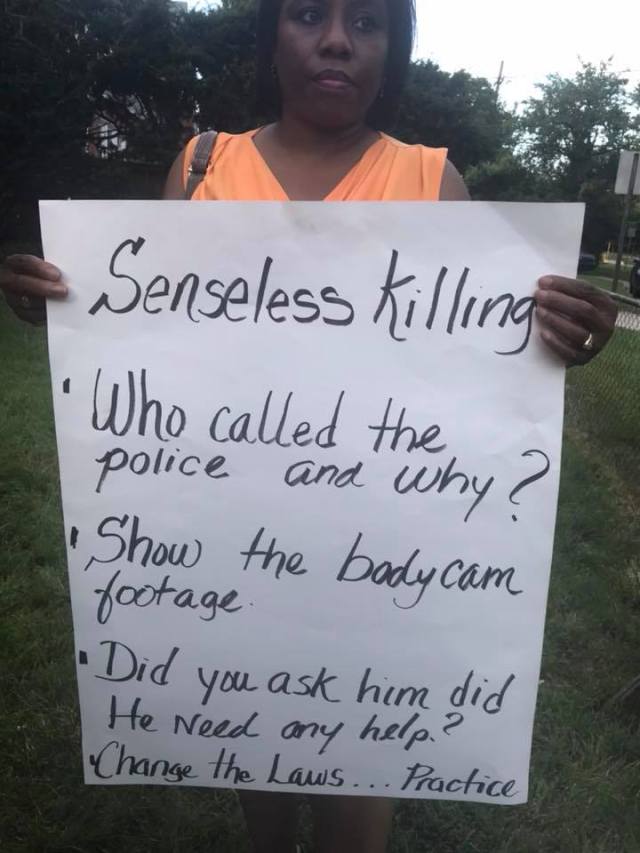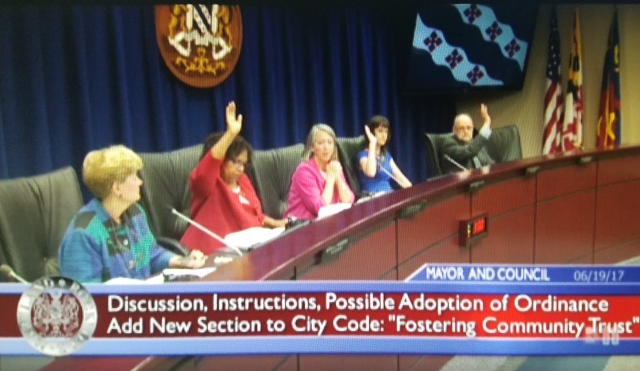
Family and friends raised questions at a June 18 vigil for Robert White outside his family home.
News from: Black Lives Matter DC-Direct Action Pod; Jews United for Justice, Moms of Black Boys United for Social Change, Inc.; Montgomery County Civil Rights Coalition; Progressive Action Montgomery County; Showing Up for Racial Justice Montgomery County; Silver Spring CHEER; South Asian-Americans Leading Together; Takoma Park Mobilization-Ending Mass Incarceration
Over 600 individuals from throughout Montgomery County, Maryland, along with six local organizations, have signed and delivered a community letter outlining their concerns about policing in the county. The letter raises concerns in the wake of the shooting death of Robert White, a black man who was killed about one mile from his childhood home in Silver Spring on June 11. He was killed while on foot near his neighborhood, which he walked routinely, according to neighbors.
The letter is addressed to County Executive Ike Leggett, Police Chief Thomas Manger, and Councilmember and Public Safety Committee Chair Marc Elrich. In the letter, the community groups and more than 600 signers raise a wide range of concerns about how policing policies impact community safety and trust in the police, especially for black people and communities of color, those who suffer from mental illness, and people with developmental disabilities.
Police Chief Manger has responded to the letter and his office has scheduled a meeting on Wednesday, June 27, at the third district police station to address the questions raised in the letter. Elrich has indicated that he will send a representative from his office to attend the meeting. As of Sunday night, June 24, Leggett has not responded to the group’s letter.
Two members of the Montgomery County delegation to the Maryland General Assembly, Senator Will Smith and Delegate Jheanelle Wilkins, responded to the letter and indicated they are closely monitoring the incident.
Police have not released body camera footage from the scene, as the case remains under investigation by the Howard County State’s Attorney office, under a 2015 agreement between the two counties intended to demonstrate investigative independence. Montgomery County police have released few other details. The officer involved in the shooting is not required by law and has elected not to give a statement to criminal investigators regarding the shooting. Once the criminal investigation is complete, the officer will be required to provide information to police as part of the Department’s internal investigation.
In 2017, Montgomery County Police documented 523 incidents of “use of force,” which included use of force in one out of every 37 arrests. There were three uses of deadly force by police in 2017. Two-thirds of all “use of force” incidents in the county involved people of color.
Also in Silver Spring (where White was killed), in November 2017, a county police officer shot an unarmed driver who was inside his vehicle. The man, who was not charged with any crime, was injured when the officer’s gun discharged as he used the gun to open a car door while the shooting victim was inside the car. Updated information on how this case was resolved, including body camera footage that was shared with Howard County, as well as findings or discipline related to the officer, have not been shared with the public.
Cases of use of force that go without public explanation are not new to Montgomery County. For example, another Silver Spring incident documented on video by a resident shows an officer punching a black man in a Silver Spring parking lot multiple times; the resident does not appear to be aggressive or resistant. A public request for information regarding whether the officer was disciplined was referred by Internal Affairs for a public information request. However, disciplinary records of police officers are protected as private personnel matters under the Maryland Public Information Act, Section 4-311 (affirmed by Maryland Department of State Police v. Dashiel, 2014.)
Chief of Police Thomas Manger has publicly stated his support for police transparency, and has received awards citing a commitment to transparency and accountability. However, the Fraternal Order of Police has resisted calls to strengthen civilian participation in disciplinary reviews, and the Maryland law enforcement bill of rights, codified as state law, remains a barrier to transparency. Twenty-seven other states make police disciplinary records available to the public, according to the ACLU.
White was remembered by family, friends, and neighbors at a vigil held at his home in Silver Spring on Monday, June 18.. Friends remembered White as someone who was always friendly and caring, and said he had a knack for making others laugh. White struggled with mental health issues, according to family and friends. Despite his own struggles, his close childhood friend remembered how well White supported others, checking in daily or every other day with him to see how he was doing, and fondly recalled spending time in his home and playing together as children in Silver Spring. White attended Silver Spring schools Highland View Elementary School, Eastern Middle School, and Montgomery Blair High School. Friends and family are calling for transparency and justice for White.






